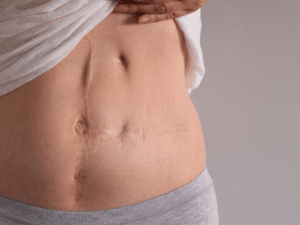Obesity is an epidemic not only in the United States but in the world. In the United States alone 1 in every 3 adults suffers from obesity. Surgeons now consider some of the safest forms of surgery to be performing bariatric or weight loss surgery laparoscopically.
Any form of surgery comes with associated risks but in the case of bariatric surgery, the benefits almost always outweigh the risks. Today we are going to discuss different types of weight loss surgery and the safest kinds of bariatric weight loss.
Risks of Obesity vs. Surgery
Bariatric surgeons have proven that this decades–old thinking about bariatric surgery being high risk for mostly cosmetic rewards is wrong.
Obesity increases the risk of several diseases and serious health conditions. Lowers an individual’s quality of life and affects and limits their ability to function physically like navigating stairs, sitting in a chair, or playing with their children. It is also connected with mental and emotional health disorders such as anxiety and clinical depression.
The risks of fatal complications from bariatric surgery are extremely rare and when compared with the risk of death from one of the many side effects (comorbidities) of obesity pale in comparison.
Patients who undergo bariatric surgery and lose weight are:
- 40% less likely to die from heart disease.
- 92% less likely to die from type 2 diabetes.
- 60% less likely to die from cancer.
Obesity-Related Diseases
Several illnesses directly associated with obesity require ongoing medication or medical intervention. It can lead to an untimely death if left untreated. Weight–related health issues include:
- Type 2 Diabetes.
- Coronary Disease.
- High Blood Pressure or Hypertension.
- High Cholesterol and Other Cholesterol Issues.
- Stroke.
- Gallbladder Disease.
- Osteoarthritis – Breakdown of Cartilage and Bone within a Joint.
- Sleep Apnea and Breathing Problems.
- Several Different cancers.
Is Bariatric Safest Weight Loss Surgery?
Obesity is not only a weight problem or one that shows a lack of willpower but also a metabolic disease with complexity. In many cases, a patient’s metabolism is working against them while they are doing their best to follow their diet and exercise plan.
The metabolic changes their body attempts to enforce can be countered by these patients with the help of bariatric surgery, which is considered one of the most effective and safest ways to help them with the challenges of losing weight.
According to the American Society of Metabolic and Bariatric Surgery (ASMBS), a patient whose body mass index (BMI) has risen above 35 has less than a 1% chance of achieving a healthy body weight and maintaining it on their own without medical intervention.
Safest Weight Loss Surgery Weight Loss Surgery Options
There are different types of weight loss surgeries available and most are done laparoscopically. Despite the technique, all offer individuals the opportunity to achieve significant weight loss. But what is the best weight loss surgery? Let’s take a look at the different options available.
Laparoscopic Sleeve Gastrectomy, Gastric Sleeve, or VSG/LSG
- The surgeon places the pouch across the stomach from the point of the pouch opening to create a stapler–like shape.
- The reduced stomach size aids in portion control. As well as, greatly reduces the production of the hormone ghrelin (this is the hormone that stimulates hunger).
- Sleeve Gastrectomy Surgery helps a patient lose weight through restrictive techniques but does not make alterations to the digestive system that affect the absorption of nutrients.
- Other forms of bariatric surgery often use this procedure as the first step, but it is not reversible.
Gastric Sleeve
Researchers have been collecting historical data and conducting many studies for more than two decades to evaluate the safety and efficacy of laparoscopic gastric sleeve surgery.
A study conducted in Spain followed patients for five years after having a laparoscopic sleeve gastrectomy procedure. Eight patients experienced side effects that were controlled and some patients experienced acid reflux or gallstones. Despite the few side effects, 75% of the patients in the study experienced remission from type 2 diabetes. And 72% remission from high blood pressure.
The researchers consider gastric sleeve surgery one of the safest bariatric surgical procedures to undergo, and they deem it safe or safer than other forms of surgery.
Gastric Bypass or Roux-en-Y Surgery
- 70% of the patient‘s stomach is permanently removed, shaped into a small pouch, and secured along the cut edge with staples in sleeve gastrectomy.
- The surgeon alters the way food is ingested and restricts the absorption of calories by cutting and rerouting the small intestine to attach to the lower part of the pouch, skipping much of the small intestine and then connecting further down.
- Surgeons employ both restrictive and malabsorptive techniques to perform gastric bypass surgery, although it carries a high risk and is not recommended. However, they can revise the surgery as necessary. The procedure is known as Bariatric Revision Surgery.
Duodenal Switch Surgery
- Similar to Gastric Bypass surgery, the Duodenal Switch combines both restrictive and malabsorptive properties to help patients lose weight.
- A sleeve gastrectomy makes the patient‘s stomach smaller, and then alters the digestive system in two different locations, creating a more malabsorptive environment than gastric bypass surgery does.
- When measuring the most significant weight loss in patients, doctors consider the duodenal switch the best weight loss surgery, though it is not reversible.
Laparoscopic Adjustable Gastric Band
- Gastric Band Surgery uses a restrictive technique to help patients lose weight.
- Doctors cinch an inflatable band around the top part of the stomach which divides it into two sections.
- The smaller section becomes the main stomach and the opening between the two sections causes the ingested food to flow very slowly from the top section to the bottom section.
- The patient feels “full” quicker and can not eat as much food due to the smaller stomach size. The surgeon will implant a port underneath the patient‘s skin and inflate or deflate the ring positioned around the stomach to adjust the opening between the two sections.
- Widely considered the safest form of bariatric surgery for several years. Today bariatric surgeons do not use it because it yields inadequate weight loss results and a high rate of long–term complications. By 2015 gastric lap band usage was down to approximately 5.7% compared to the other bariatric surgery choices.
- Gastric band surgery is fully reversible.
Non-Surgical Safest Weight Loss Surgery Options
With the advancements in the industry medically assisted weight loss has come a long way.
There are now a few non-surgical choices for higher-weight individuals who do not desire surgery. Or would be unable to physically withstand a long surgical procedure due to their health. Also, some lower BMI patients can benefit from these procedures. As it offers them the ability to be proactive and avoid obesity by safely and effectively helping them lose weight.
Sometimes super higher weight patients will use one of these procedures. As a stepping stone to help them lose some initial weight so they can safely proceed with another form of bariatric surgery.
Gastric Balloon – Orbera
- A silicone balloon is used by patients to lose weight by taking up space in the stomach, which limits them to only eating small quantities of food at a meal through the Orbera Gastric Balloon.
- During a procedure that takes between 20–30 minutes, a doctor uses an endoscope to place a deflated Orbera balloon into the stomach and fill it with saline to a pre–determined size.
- The balloon helps the patient feel “full” and limits the amount they can eat to help them lose weight.
- There is no hospital stay required and only about a 3-day recovery period.
- Gastric balloons are for temporary use only and are removed after six months.
- The balloon‘s objective is to jump–start the patient’s weight loss and acclimate them to a healthier diet, exercise profile, and overall lifestyle so they can continue to lose weight and maintain their weight loss results into the future. We continuously support patients during their time with the balloon and afterward as we remove it.
What Is The Safest And Least Invasive Weight Loss Surgery?
What is the safest form of weight loss surgery? This is one of the most popular questions asked of most bariatric specialists today.
The answer may surprise you but many bariatric doctors’ responses will not involve surgery at all. An endoscopic procedure called Endoscopic Sleeve Gastroplasty. This fairly new procedure is taking the bariatric weight loss industry by storm. With its significant weight-loss potential, low risk and complication rate, and non-surgical approach.
What Is Endoscopic Sleeve Gastroplasty (ESG)?
- A doctor performs ESG or endoscopic sleeve gastroplasty by lowering an endoscope down the patient‘s throat without needing to make any incisions.
- A camera, with room for additional surgical tools, equips the very thin flexible tube known as an endoscope to access the procedure site.
- The endoscope lowers a special suturing device to strategically place 7–12 sutures in the stomach, reducing its size and reshaping it into a sleeve–like pouch resembling a banana.
- The procedure takes about 30 to 45 minutes and does not require a hospital stay.
How Does ESG Work to Help Patients Lose Weight?
The ESG procedure reduces the patient‘s stomach by 70–75%, and the remaining 25% will be used as the stomach going forward.
Because the patient is working with a smaller stomach they will not be able to eat as much food during a meal and it will take longer for the food eaten to digest. This will also extend the length of time that the patient feels “full” which will help keep them from “grazing” between meals.
Endoscopic Sleeve Gastroplasty offers alteration results that closely resemble the Surgical Gastric Sleeve (VSG). But without the surgery, risks, associated complications, or extended recovery time.
Patients follow a specified diet plan after the procedure starting with liquids. Eventually, they work their way back up to solid foods. This transition takes place much faster than after a surgical procedure and in total usually just lasts a few weeks.
Most patients can return to work after about a week as long as their job is not labor-intensive. The bariatric surgeon will determine when the patient can return to their normal routine. Generally, it is not longer than 3-4 weeks.
Studies Support Significant Weight Loss Potential Through ESG
Studies have proven Endoscopic Sleeve Gastroplasty to be as effective as Gastric Sleeve Surgery. While offering the benefit of being one of the safest forms of weight loss. Since it is not a surgical procedure. The overall complication rate of ESG is less than 1% while offering the potential for significant weight loss.
ESG surpassed the expected target of 25% EWL. The percentage of expected excess weight loss in clinical trials reached almost twice that at 49% in 12 months.
- Only 3 out of 150 patients who took part in this trial had minor complications. Eventually, all were resolved without any surgical intervention>
- Patients in the study also showed significant improvements in their weight-related health issues and none developed GERD (severe acid reflux).
NCBI study stated that 12–month weight loss stats for gastric sleeve and bypass surgery.
- Gastric Sleeve Surgery -43%>
- Gastric Bypass Surgery – 51%>
- ESG Non-Surgical Outpatient Procedure – 49%.
Safest Weight Loss Surgery at IBI HealthCare
ESG is the leading, safest, and least invasive weight–loss choice in the US. Contact us to learn more about how it can help you.
At IBI Healthcare Institute, we know that losing weight is a process and requires many challenging lifestyle changes. Partner with us—lose weight, reach goals, become healthier.











